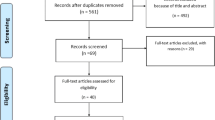Abstract
Design The study was a systematic review and meta-analysis conducted in accordance with the PRISMA (Preferred Reporting Items for Systematic Reviews and Meta-Analyses) statement and the guidelines from the Cochrane handbook for systematic reviews of interventions.
Data sources Literature searches of free text and MeSH terms were performed using Medline (PubMed), Scopus, Google Scholar and the Cochrane Library (from 2000 to 30 June 2020). The search strategy was: ("oral screening devices" or "autofluorescence" or "chemiluminescence" or "optical imaging" or "imaging technique") and ("oral dysplasia" or "oral malignant lesions" or "oral precancerosis").
Data analysis After identification of 1,282 potential articles, an analysis applying the eligibility criteria to the research identified 43 articles for qualitative evaluation and 34 for quantitative analysis.
Results The results presented were inconsistent, both in the whole and in technique groups. There was evidence of high risk of bias in the evaluated studies. Moreover, the results were homogeneous across studies, which makes it challenging to carry out a reliable comparison of measures like specificity or positive/negative predictive values.
Conclusions Imaging-based techniques for early diagnosis of potentially malignant oral lesions must improve technology and accuracy. In addition, none of the evaluated methods can substitute the oral biopsy.
Similar content being viewed by others

Explore related subjects
Discover the latest articles, news and stories from top researchers in related subjects.A Commentary on
Mazur M, Ndokaj A, Venugopal D C et al.
In Vivo Imaging-Based Techniques for Early Diagnosis of Oral Potentially Malignant Disorders-Systematic Review and Meta-Analysis. Int J Environ Res Public Health 2021; 18: 11775.

GRADE rating
Commentary
The early diagnosis of malignant lesions is a relevant topic nowadays due to the increase in the incidence in the world population.1 Therefore, the importance of quickly and efficiently identifying and diagnosing potentially malignant lesions is a significant concern among healthcare specialists. In addition, erythroplakia (red) and leukoerythroplakia (white and red) lesions in the oral cavity may provide clinical signs of potentially malignant lesions.2
Since the early 1980s,3 vital colourants have been used as one of the methods to diagnose oral cancer. Among the main dyes, toluidine blue and tolonium stand out. However, these materials are inconclusive and may generate faintly or false-positive cases.4

© Md Babul Hosen/iStock/Getty Images Plus
More recent evaluation methods, such as autofluorescence, high-resolution microendoscope, optical spectroscopy and narrow banding imaging, present some clinical studies that help in the evaluation/identification process of potentially malignant lesions.5,6,7 However, these materials can be expensive in addition to specialised training. In addition, they may have false positives for dysplastic or inflammatory lesions.8
The recent review published by Mazur et al.9 is a relevant study that evaluates these imaging-based techniques for early diagnosis of oral potentially malignant lesions. In this research, it is possible to observe that all these methods have limitations, regardless of the degree of technology used. The decision to use these methods as a substitute for the surgical procedure (incisional/excisional biopsy) followed by histopathological evaluation can have severe consequences for the patient, such as the evolution of the pre-malignant lesion to oral cancer resulting in an unfavourable prognosis.
The main question that should be on experts' minds is whether they would risk using inaccurate or non-100% accurate methods on their family members and/or friends.
References
Warnakulasuriya S. Oral potentially malignant disorders: A comprehensive review on clinical aspects and management. Oral Oncol 2020; 102: 104550.
Rao N R, Villa A, More C B, Jayasinghe R D, Kerr A R, Johnson N W. Oral submucous fibrosis: A contemporary narrative review with a proposed inter-professional approach for an early diagnosis and clinical management. J Otolaryngol Head Neck Surg 2020, 49: 3.
Li Y N, Lu R, Zhang J, Zhou G. Inter-and intra-observer agreement on the judgement of toluidine blue staining for screening of oral potentially malignant disorders and oral cancer. Clin Oral Investig 2019, 23: 1709-1714.
Jayasinghe R D, Hettiarachchi P, Amugoda D et al. Validity of Toluidine Blue test as a diagnostic tool for high-risk oral potentially malignant disorders - A multicentre study in Sri Lanka. J Oral Biol Craniofac Res 2020, 10: 547-551.
Esteva A, Kuprel B, Novoa R A et al. Dermatologist-level classification of skin cancer with deep neural networks. Nature 2017, 542: 115-118.
Gulshan V, Peng L, Coram M et al. Development and validation of a deep learning algorithm for detection of diabetic retinopathy in retinal fundus photographs. Am Med Assoc 2016, 316: 2402-2410.
Schwendicke F, Golla T, Dreher M, Krois J. Convolutional neural networks for dental image diagnostics: A scoping review. J Dent 2019, 91: 103226.
Pavlova I, Williams M, El-Naggar A, Richards-Kortum R, Gillenwater A. Understanding the biological basis of autofluorescence imaging for oral cancer detection: High-resolution fluorescence microscopy in viable tissue. Clin Cancer Res 2008; 14: 2396-2404.
Mazur M, Ndokaj A, Venugopal D C et al. In Vivo Imaging-Based Techniques for Early Diagnosis of Oral Potentially Malignant Disorders - Systematic Review and Meta-Analysis. Int J Environ Res Public Health 2021; 18: 11775.
Author information
Authors and Affiliations
Corresponding author
Rights and permissions
About this article
Cite this article
de Almeida Barros Mourão, C., Javid, K. Are the imaging-based techniques for early diagnosis of oral potentially malignant lesions effective?. Evid Based Dent 23, 26–27 (2022). https://doi.org/10.1038/s41432-022-0244-0
Received:
Accepted:
Published:
Issue Date:
DOI: https://doi.org/10.1038/s41432-022-0244-0
- Springer Nature Limited



